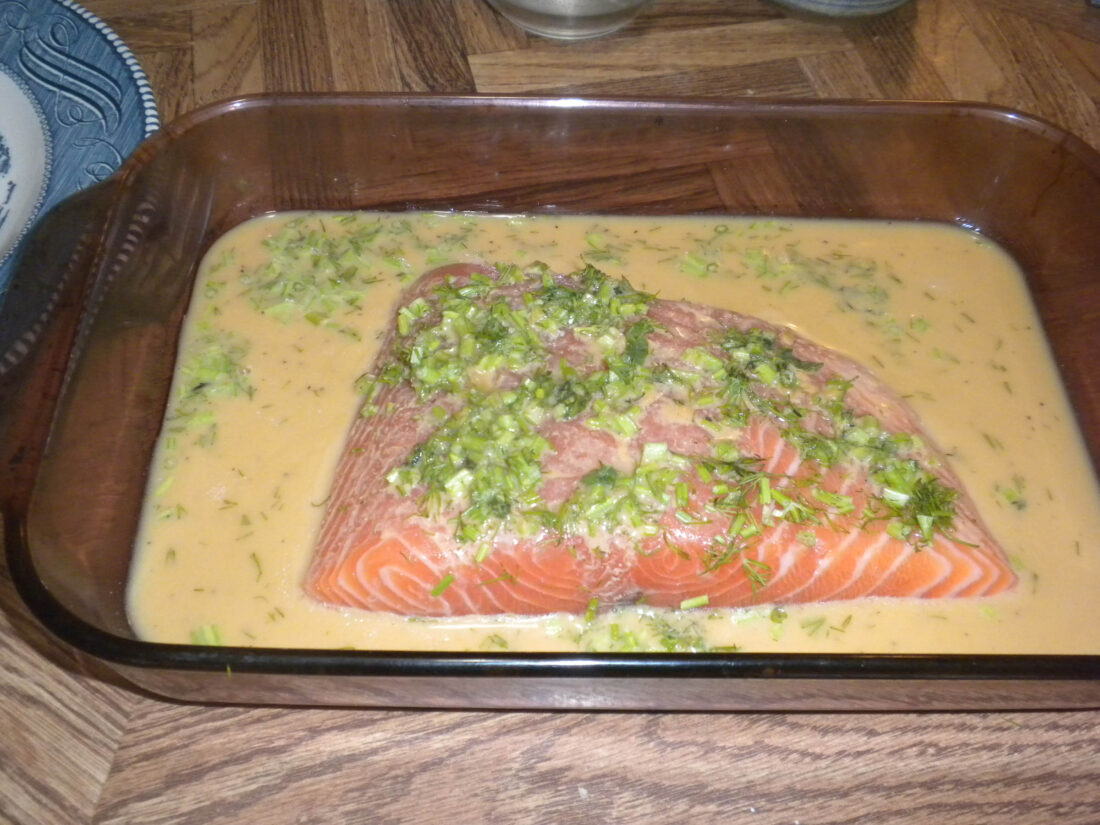It’s maple sugar time!

Salmon with dill, mustard and wine sauce (Provided photo — Yvona Fast)
“The gift of the sugar maple trees is from a benevolent Providence.”
— Benjamin Rush, in a letter to Thomas Jefferson.
The calendar still says winter. But warm days and below-freezing nights have meant that even in February, some producers were tapping trees for the season’s sweet sap.
March 18-19 is still technically winter, while March 25-26 is officially spring. These are the two maple weekends this year.
Want to find maple weekend activities near your home? Check out www.mapleweekend.com. Here you will find a listing of maple sites and shops throughout New York state, informative articles, delicious recipes and children’s activities.
During maple weekends, many area maple producers open to the public for free tastings and tours. Some include paid events, like pancake breakfasts. All have syrup, sugar, candy and other maple products for sale.
Celebrate maple syrup because it is a healthy sweet! This pure, natural, sustainable sweetener comes loaded with riboflavin and important minerals: Potassium, calcium, zinc, manganese, iron and magnesium. Maple syrup contains more than 54 naturally occurring beneficial compounds — antioxidants, polyphenols and other phytochemicals. These prevent the oxidation and aging of body cells, improve immunity, reduce inflammation, prevent cancer and help to manage Type 2 diabetes.
Anyone with a little knowledge and some basic equipment can produce syrup — and it can be a fun family activity. While commercial producers use expensive tubing and boilers, Indigenous Americans in used wooden spikes to make holes in the tree for the sap to drip. They collected sap in wooden or bark baskets placed below the spike and boiled the sap in clay pots over wood fires.
European colonists learned to make syrup from the natives. They had more advanced technology, and used augers to drill holes in the tree. They inserted wooden spouts into these holes and hung buckets from them to collect the sap. They boiled the sap in iron pots over a wood fire.
Advances in technology have speeded up the evaporation process. By the mid-1800s, flat metal pans were used to boil syrup instead of pots. This increased the surface area exposed to heat. By 1900, flues in the bottom of the boiling pans increased the surface area even more. Today, commercial producers use plastic tubing and vacuum pumps to move the sap from the sugarbush to the sugar shack.
You can use modern technology for large-scale commercial production. You can gather sap in buckets and bring it home to cook on your kitchen stove. Or anything in between.
If you have no desire to try your hand at making your own syrup, you can buy delicious, local syrup from producers in your region. In addition to pouring it simply onto pancakes, waffles, or breakfast oatmeal, syrup can be used in your kitchen in so many ways! From desserts to salad dressings, from candy to seasoning meat and vegetables, there are many recipes for using syrup. My favorites are mustard and maple salmon and a maple vinaigrette for my salad.
–
Maple Mustard Salmon
–
Ingredients:
A little oil for the pan (about a teaspoon of olive oil)
2 salmon fillets, about 4-6 ounces each
2 Tablespoons prepared mustard
1 Tablespoon maple syrup
1 clove garlic, minced (optional)
1/4 cup fresh minced dill weed
1/4 cup white wine
1/4 cup broth (vegetable or chicken, or potato or pasta cooking liquid)
Directions:
Preheat oven to 375 degrees F.
Oil a baking dish large enough to fit the salmon.
Spread the salmon with mustard, drizzle with maple syrup, sprinkle garlic and dill over. Or combine mustard, syrup, garlic and dill in a small dish and spread on top of salmon.
Pour wine and broth into the baking dish.
Place in preheated oven until fish flakes with a fork, about 12-15 minutes.
Serve with potatoes and vegetable. Serves 2.
–
Napa and Apple Salad with Maple Vinaigrette
–
Ingredients:
Maple vinaigrette
1 or 2 Tablespoons extra-virgin olive oil
1 Tablespoon prepared mustard
1/2 to 1 teaspoon salt
1/4 teaspoon black pepper, optional
3 Tablespoons cider vinegar
3 or 4 Tablespoons maple syrup
For the salad:
3 cups coarsely chopped Napa cabbage
1 carrot (about 1 cup shredded)
2 unpeeled apples, cored and sliced thin
1 orange, peeled and cut up
1 cup finely chopped spinach or tender kale
1/2 cup raisins
1/2 cup walnuts
Directions:
Combine vinaigrette ingredients in a jar with a tight-fitting lid. Shake well.
Combine Napa, carrot, kale or spinach, orange and apples in salad bowl. Shake dressing, pour over and stir well to combine.
This salad is best made a little ahead so flavors can combine.
Before serving, toast walnuts by spreading on a cookie sheet and toasting in a hot (425 degrees F) oven for two minutes. Be careful not to burn. Stir walnuts into salad right before serving.
This step can be omitted if you’re short on time, but the nuts are so much better when toasted.
— — —
Author of the award-winning cookbook “Garden Gourmet: Fresh & Fabulous Meals from your Garden, CSA or Farmers’ Market,” Yvona Fast lives in Lake Clear and has two passions: cooking and writing. She can be found at www.yvonafast.com and reached at yvonawrite@yahoo.com or on Facebook at Words Are My World.



